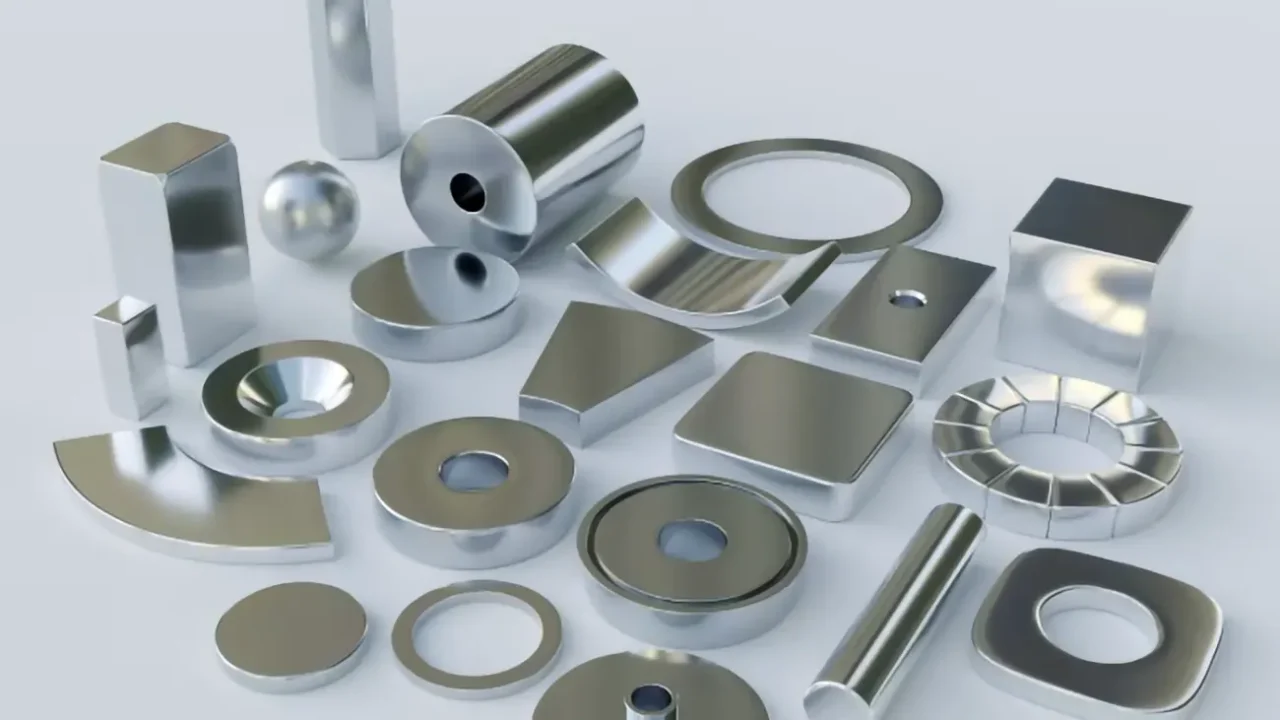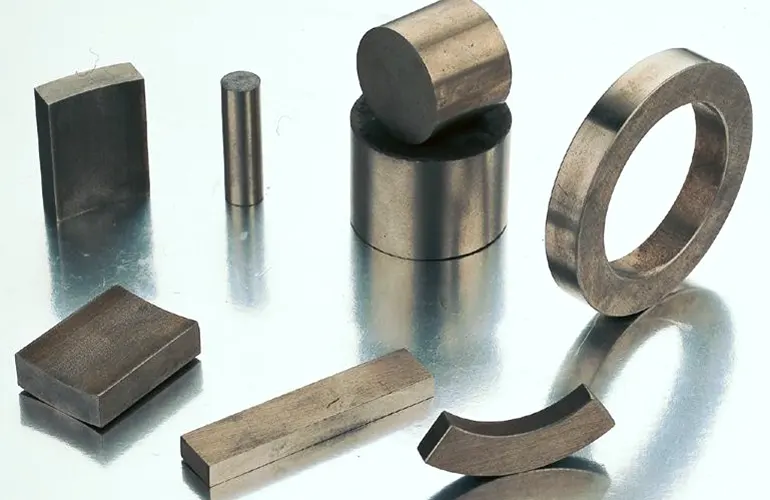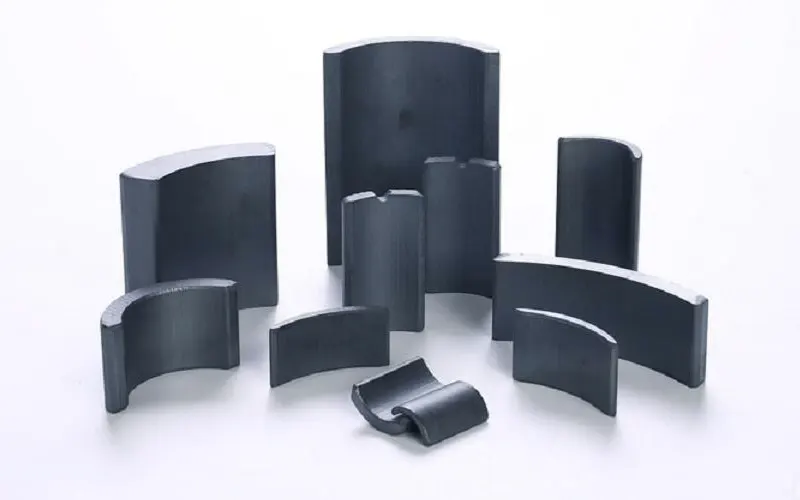Neodymium (Neo) magnets, especially N52, N54, and N55, are among the strongest available today. But which one is truly the most powerful? Beyond strength, factors like heat resistance and magnetic field range also matter.
This article compares N52, N54, and N55 magnets, examining their differences in performance and applications. We’ll also explore what defines the strongest magnet overall, helping you choose the right one for your needs.
What is N52 magnet?

An N52 magnet is a neodymium magnet with an energy product (BH)Max of 52 MGOe (Mega-Gauss Oersteds). The “N52” refers to its strength, making it the strongest neodymium magnet available.
Neodymium magnets are made from a mix of neodymium, iron, and boron, which gives them incredible magnetic power. There are other grades, like N35, N38, N42, N45, and N48—the higher the number, the stronger the magnet. Since N52 magnets have the highest strength, they also tend to be more expensive than lower-grade magnets.
What is N54 Magnet?
N54 magnets are the most powerful N series neodymium magnets that can be mass-produced. However, N52 magnets are still often considered the most powerful permanent magnets for holding applications. With the increasing demand for higher magnetic flux density from magnetic separation and filtration producers, the mass production of N54 magnets has become feasible at some large-scale NdFeB manufacturers. Currently, many NdFeB manufacturers can produce these magnets in bulk. Since there’s no international standard yet, some people even refer to them as N55 magnets. Due to the lack of current international standards, some manufacturers and customers also use the name N55 magnet.

The N54 grade magnet is a super strong sintered NdFeB permanent magnet, and it has even greater magnetic strength than N52. Here’s the lowdown on what the N54 magnet is all about, including its specifications, uses, and the demagnetization curve.
I have sorted out the magnetic performance data of N54 magnets, hoping that everyone will have a clearer understanding of N54 magnets.
| Grade | Br | HcJ | HeB | (BH) ax | Working Temperatur | Curie Tempera ture | ||||||
|---|---|---|---|---|---|---|---|---|---|---|---|---|
| N54 | kGs | T | kOe | kA/m | kOe | kA/m | HGOe | kJ /m3 | C | C | ||
| Min | Min | Min | Min | Min | Min | Min | Max | Min | Max | Max | Max | |
| 14.5 | 1.45 | 11 | 875 | 10.5 | 836 | 51 | 55 | 406 | 438 | 80 | 310 | |
What is N55 Magnet?
The N55 magnet is currently one of the strongest magnets available for commercial use. Neodymium rare earth magnets are measured on a scale from 24MGOe to 55MGOe in terms of strength. This new grade of neodymium magnets is 5-6 percent stronger compared to the more commonly used N52 grade. The N55 grade of NdFeB represents the pinnacle of permanent magnet technology, with unmatched magnetic strength. While it may not be suitable for every application, the N55 grade offers distinct advantages in specific cases.
These magnets are particularly useful in applications requiring maximum magnetic strength in a small space. Due to its powerful magnetic field, the N55 grade is ideal for precise and delicate work where size really matters. It is truly a super-strong magnet. For instance, the Magma engineering team used these high-power magnets in a newly developed magnetic bearing prototype, ensuring maximum efficiency and power through finite element analysis.
The N55 neodymium magnet is one of the strongest magnets currently available for commercial use. The theoretical (BH)max value of the N55 NdFeB magnet is 512k/m3 (64MG0e). While most magnet manufacturers can now produce N52 magnets, the (BH)max of N52 already reaches 90% of its theoretical limit. The N55 grade offers even stronger magnetic force, making it the most powerful commercially available grade today.
Comparison of N52, N54, and N55 Neodymium Magnets.
There’s something truly exhilarating about neodymium magnets—these tiny powerhouses hold an almost otherworldly force, shaping industries and redefining what’s possible. Among them, N52, N54, and N55 stand as the titans, each with its own magnetic personality. But what sets them apart? And which one is the ultimate force to be reckoned with? Let’s dive in—not with cold, technical jargon, but with genuine passion for these incredible materials.
Magnetic Strength: The Heartbeat of a Powerful Magnet
- N52 – The industry’s beloved standard, delivering 14.3–14.7 kGs of remanence (Br) and a BHmax of 52 MGOe. A workhorse that balances strength, affordability, and availability.
- N54 – A step up in intensity, with 14.5–15.0 kGs Br and BHmax nearing 54 MGOe. Stronger than N52, but not as dominant in the market due to production complexities and costs.
- N55 – The pinnacle of strength, pushing BHmax to 55 MGOe. The sheer force it generates is breathtaking, making it the strongest neodymium magnet commercially available.
| Grade | Br (KGs) | Br (T) | Hcb(kOe) | Hcb(KA/m) | Hcj (KOe) | Hcj (KA/m) | (BH)max (MGOe) | (BH)max (kJ/m³) | Temp. Limit | Cost | Applications |
|---|---|---|---|---|---|---|---|---|---|---|---|
| N52 | 14.2-14.6 | 1.42-1.46 | ≥10.5 | ≥955 | ≥12 | ≥955 | 50-53 | 398-422 | 80°C | Moderate | Electronics, EVs, Industry |
| N54 | 14.5-15 | 1.45-1.5 | ≥10.5 | ≥836 | ≥11 | ≥915 | 52-55 | 414-438 | 80°C | High | Compact designs |
| N55 | 15.2-15.5 | 1.52-1.55 | ≥10.5 | ≥836 | ≥11 | ≥876 | 53-56 | 422-446 | 60°C | Very High | Aerospace, Military |
It’s not just about the numbers—it’s about the feeling of holding an invisible yet undeniable power in your hands. The difference between these grades might seem like a few percentages, but in real-world applications, that extra magnetic punch can redefine efficiency and design possibilities.
Where Do They Shine? Real-World Applications
- N52: The go-to for consumer electronics, renewable energy, industrial automation, and electric vehicles. It’s everywhere because it’s strong, reliable, and cost-effective.
- N54: Ideal for designs where slightly stronger fields matter, though its higher cost means it’s often reserved for specialized engineering projects.
- N55: A magnet for the future—pushing limits in aerospace, defense, and cutting-edge technology, where every bit of strength counts in ultra-compact spaces.
Each of these magnets plays a role in pushing humanity forward, making our world faster, more efficient, and more innovative.
Which One is the Strongest?
N55, hands down, wins the raw power battle. It has the highest BHmax and Br, making it the undisputed champion in magnetic intensity. But power isn’t everything. N52 still dominates the industry because of its balance between strength, cost, and availability. At the same time, N54 is in the middle, stronger than N52 and has the same resistance to demagnetization as N52.
There’s something magical about neodymium. It’s the unseen force driving technological revolutions. Whether it’s powering wind turbines, making electric cars more efficient, or helping satellites navigate space, these magnets are silent heroes of progress. And that’s what makes them so fascinating. It’s not just about strength—it’s about the endless possibilities they unlock.
| Feature | N52 | N54 | N55 |
|---|---|---|---|
| Remanence (Br) | 14.3 – 14.7 kGs | 14.5 – 15.0 kGs | 14.8 – 15.2 kGs |
| BHmax | ~52 MGOe | ~54 MGOe | ~55 MGOe |
| Strength | Strong | ~3% stronger | ~5-6% stronger |
| Temp. Limit | ~80°C | ~80°C | ~60°C |
| Cost | Moderate | High | Very High |
| Applications | Electronics, EVs, Industry | Compact designs | Aerospace, Military |
What Is the Strongest Magnet?
Magnets hold an undeniable allure, shaping the modern world in ways both seen and unseen. From the smallest electronic components to industrial marvels, their invisible force commands attention. But when it comes to defining the “strongest” magnet, the answer isn’t as simple as it seems. Strength can be measured in multiple ways—magnetic intensity, temperature resistance, and field decay distance—each revealing a different champion.
Magnetic Strength: The Unrivaled Power of Neodymium Magnets
If sheer magnetic force is the measure, neodymium magnets stand unchallenged. Composed of neodymium, iron, and boron (Nd₂Fe₁₄B), these rare-earth magnets boast the highest magnetic energy product, reaching up to 55 MGOe. Their immense pull has revolutionized industries, making them indispensable in high-performance motors, medical imaging, and even the tiniest earbuds. However, their strength comes with a trade-off—they are prone to corrosion and lose magnetism at elevated temperatures.
Heat Resistance: The Endurance of Samarium-Cobalt Magnets
When the environment turns extreme, samarium-cobalt (SmCo) magnets take center stage. Operating at temperatures up to 350°C without significant performance loss, they thrive where neodymium falters. Though slightly weaker in magnetic intensity compared to neodymium, their reliability under heat makes them an irreplaceable force in demanding conditions.
Field Decay Distance: The Reach of Ferrite Magnets
Magnetic power isn’t just about brute strength—it’s also about how far that force extends. While ferrite magnets (Fe₂O₃-based) may lack the intense pull of rare-earth magnets, they excel in sustaining a magnetic field over greater distances. Used in large-scale industrial applications, loudspeakers, and even household appliances, their durability and resistance to demagnetization make them an enduring presence in the magnet world.
Each type of magnet carries its own unique strength, proving that “the strongest” depends on what matters most. Whether it’s the sheer intensity of neodymium, the heat resilience of samarium-cobalt, or the long-reaching influence of ferrite, magnets continue to shape technology, innovation, and the future. Their invisible power is nothing short of extraordinary—a force that both binds and inspires. In-depth understanding of the detailed differences between different types of magnets.
| Magnet Type | Magnetic Strength (BH max) | Max Temp | Field Reach | Key Use |
|---|---|---|---|---|
| Neodymium (NdFeB) | Up to 55 MGOe | 80°C | Short-range | Electronics, motors |
| Samarium-Cobalt (SmCo) | 16-32 MGOe | 350°C | Medium-range | Aerospace, high-temp apps |
| Ferrite | 3.5 MGOe | 180°C | Long-range | Industrial, cost-effective |
What factors should be considered when choosing the strongest magnet?
Let’s be honest—when you need a really strong magnet, it’s tempting to just grab the one with the biggest number and call it a day. But if you’ve ever watched an N52 neodymium magnet crumble in a high-temperature application or seen a cheap ferrite magnet fail under load, you know it’s not that simple.
Here’s the thing: the “strongest” magnet isn’t just about raw power—it’s about the right power for your job. Think of it like choosing a car. A Formula 1 racer is insanely powerful, but you wouldn’t take it off-roading. Same with magnets—the best one depends on where and how you’re using it.
The Material Matters More Than You Think
- Neodymium (NdFeB): The muscle car of magnets—crazy strong but hates heat. Great for tight spaces where you need max pull, like robotics or high-performance sensors. Just don’t let it cook.
- Samarium Cobalt (SmCo): The “luxury SUV” option—strong, handles heat like a champ (up to 350°C!), and won’t rust on you. Perfect for aerospace or medical devices where reliability is non-negotiable.
- Ceramic (Ferrite): The dependable pickup truck—cheap, tough, and works fine in most conditions. Not winning any strength contests, but it’ll get the job done without fuss.
- Alnico: The classic hot rod—old-school but still useful in niche cases (like guitar pickups or vintage instruments). Just don’t expect modern performance.
Pro Tip: If you’re using neodymium, pay attention to the suffix (H, SH, UH). That tells you how well it handles heat. N52 is strong, but N42SH might actually last longer in a hot environment. Learn more about the detailed neodymium magnet grade rules.
Heat Is the Silent Killer
Magnets are like people—they perform best at room temperature. Push them too far, and they start to fail.
- Standard neodymium (N grades): Starts sweating at 80°C. Fine for most indoor uses, but don’t leave it in a hot car.
- High-temp neodymium (EH, UH grades): Can handle up to 220°C—good for motors or industrial gear.
- Samarium Cobalt: Laughs at heat. If your application involves serious warmth (like inside an engine compartment), this is your best bet.
Fun Fact: If a magnet gets too hot, it doesn’t just weaken—it can permanently lose strength. And no, cooling it back down won’t fix it.
Bigger Isn’t Always Better
You might think a thicker magnet = stronger pull, but shape and positioning matter just as much.
- Thin, wide magnets spread out their pull force, great for gripping flat surfaces.
- Tall, narrow magnets focus their strength in one direction—better for precision applications.
- Air gaps kill strength. Even a tiny gap between the magnet and your target can cut its power in half.
Quick Hack: If you need more holding force, sometimes stacking two thinner magnets works better than one thick one.
The Hidden Enemies: Corrosion & Demagnetization
- Neodymium rusts. If you’re using it outdoors or in damp conditions, get it coated (nickel plating is common).
- Vibration and shock can weaken magnets over time. If your application involves movement (like in a motor), go with a higher coercivity grade.
- Other magnets or electric fields can mess with your magnet’s mojo. Keep them away from strong opposing fields unless you want a surprise demagnetization.
Cost vs. Performance: Don’t Overpay for What You Don’t Need
- Neodymium is strong but pricey. If you’re making a million fridge magnets, maybe ferrite is fine.
- Samarium Cobalt is even pricier. Only use it if you really need that heat resistance.
- Custom shapes cost more. If you can work with standard sizes, you’ll save a ton.
At Osencmag, we know the best magnet solutions come from hands-on validation. That’s why we maintain an extensive demo inventory of neodymium, samarium cobalt, and specialty magnets for rapid prototyping. Our engineers regularly help clients shortcut months of theoretical modeling with practical, real-world testing using our in-stock reference samples.
When discussing the strongest magnets available today, N52, N54, and N55 magnets stand out due to their unparalleled strength and performance. These super strong magnets are highly sought after for various industrial and technological applications. N52 magnets, for example, are known for their remarkable ability to generate powerful magnetic fields, making them ideal for use in everything from motors to medical devices. N54 and N55 magnets offer even greater strength, making them essential for cutting-edge innovations that require maximum magnetic power.
At Osencmag, we take immense pride in our deep understanding of this industry. Our expertise in manufacturing and providing high-quality magnets reflects our passion and commitment to advancing magnetic technology. We approach every challenge with sincerity and dedication, driven by a genuine love for what we do. Our strength lies not just in our products, but in the values that fuel our drive to lead and innovate in this field.
FAQs
Where is the field strongest for a magnet?
The magnetic field is strongest at the poles of a magnet. These are the ends of the magnet, where the magnetic force is the most concentrated. If you have a bar magnet, the poles are the two ends of the bar.
Why should we consider cost when choosing N52 magnets?
Cost is important when choosing N52 magnets because they are quite powerful and often come at a higher price. While N52 magnets offer exceptional strength, you want to make sure you’re getting the right value for your needs. It’s all about balancing performance with your budget.
Are N52 magnets dangerous?
N52 magnets can be dangerous if not handled carefully. They are very strong, and if they snap together unexpectedly, they can cause injury or damage. If swallowed by mistake, these magnets can attach to the mucous membranes of the intestines and other organs, causing serious damage or even death. Even during daily manual operation or handling of neodymium magnets, please wear gloves to prevent being pinched.
How much weight can an N52 magnet hold?
An N52 magnet can hold quite a bit of weight, depending on its size and shape. For example, a small N52 magnet can hold several pounds, while larger ones can hold even more. The exact weight will depend on the specific magnet’s size and the material it is attaching to.







